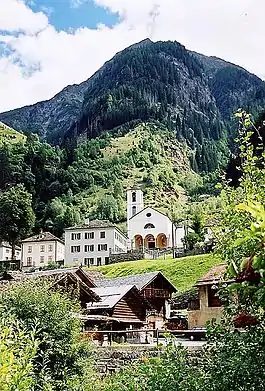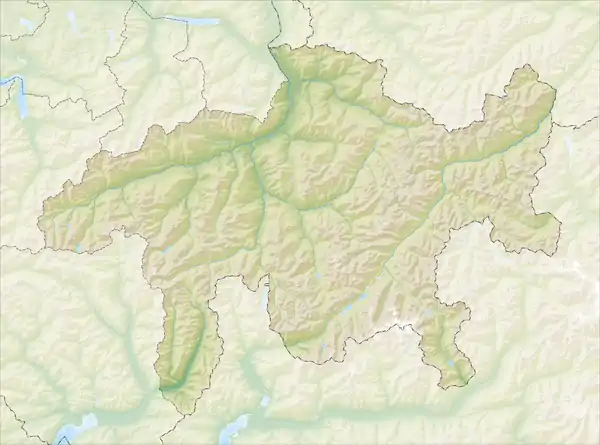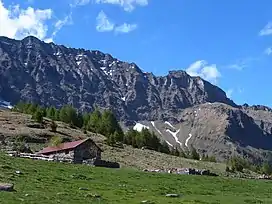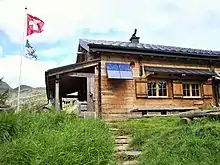Rossa, Switzerland
Rossa is a municipality in the Moesa Region in the canton of Graubünden in Switzerland. Its official language is Italian.
Rossa | |
|---|---|
 | |
 Coat of arms | |
Location of Rossa | |
 Rossa  Rossa | |
| Coordinates: 46°22′N 9°8′E | |
| Country | Switzerland |
| Canton | Graubünden |
| District | Moesa |
| Area | |
| • Total | 58.88 km2 (22.73 sq mi) |
| Elevation | 1,089 m (3,573 ft) |
| Population (31 December 2018)[2] | |
| • Total | 148 |
| • Density | 2.5/km2 (6.5/sq mi) |
| Time zone | UTC+01:00 (Central European Time) |
| • Summer (DST) | UTC+02:00 (Central European Summer Time) |
| Postal code(s) | 6548 |
| SFOS number | 3808 |
| Surrounded by | Malvaglia (TI), Biasca (TI), Mesocco, Soazza, Cauco |
| Website | rossa SFSO statistics |
History
Rossa is first mentioned in 1694.[3]
Geography


Rossa has an area, as of 2006, of 58.9 km2 (22.7 sq mi). Of this area, 9.1% is used for agricultural purposes, while 40.8% is forested. Of the rest of the land, 0.4% is settled (buildings or roads) and the remainder (49.7%) is non-productive (rivers, glaciers or mountains).[4]
Before 2017, the municipality was located in the Calanca sub-district of the Moesa district, after 2017 it was part of the Moesa Region.[5] It is the highest municipality of Val Calanca.
Demographics
Rossa has a population (as of 31 December 2020) of 151.[6] As of 2008, 10.7% of the population was made up of foreign nationals.[7] Over the last 10 years the population has decreased at a rate of -14.4%. Most of the population (as of 2000) speaks Italian (84.1%), with German being second most common (11.4%) and French being third ( 3.0%).[4]
As of 2000, the gender distribution of the population was 50.4% male and 49.6% female.[8] The age distribution, as of 2000, in Rossa is; 5 children or 3.8% of the population are between 0 and 9 years old. 6 teenagers or 4.5% are 10 to 14, and 2 teenagers or 1.5% are 15 to 19. Of the adult population, 11 people or 8.3% of the population are between 20 and 29 years old. 9 people or 6.8% are 30 to 39, 23 people or 17.4% are 40 to 49, and 19 people or 14.4% are 50 to 59. The senior population distribution is 17 people or 12.9% of the population are between 60 and 69 years old, 22 people or 16.7% are 70 to 79, there are 14 people or 10.6% who are 80 to 89, and there are 4 people or 3.0% who are 90 to 99.[7]
In the 2007 federal election the most popular party was the SP which received 37.2% of the vote. The next two most popular parties were the SVP (21.5%) and the FDP (20.2%).[4]
In Rossa about 69.3% of the population (between age 25-64) have completed either non-mandatory upper secondary education or additional higher education (either university or a Fachhochschule).[4]
Rossa has an unemployment rate of 2.22%. As of 2005, there were 4 people employed in the primary economic sector and about 3 businesses involved in this sector. 6 people are employed in the secondary sector and there are 2 businesses in this sector. 8 people are employed in the tertiary sector, with 4 businesses in this sector.[4]
The historical population is given in the following table:[3][8]
| year | population |
|---|---|
| 1683 | c. 450 |
| 1773 | 331 |
| 1850 | 186 |
| 1900 | 181 |
| 1950 | 117 |
| 1980 | 109 |
| 1990 | 108 |
| 2000 | 132 |
References
- "Arealstatistik Standard - Gemeinden nach 4 Hauptbereichen". Federal Statistical Office. Retrieved 13 January 2019.
- "Ständige Wohnbevölkerung nach Staatsangehörigkeitskategorie Geschlecht und Gemeinde; Provisorische Jahresergebnisse; 2018". Federal Statistical Office. 9 April 2019. Retrieved 11 April 2019.
- Rossa in German, French and Italian in the online Historical Dictionary of Switzerland.
- Swiss Federal Statistical Office accessed 22-Oct-2009
- Swiss Federal Statistical Office - Amtliches Gemeindeverzeichnis der Schweiz - Mutationsmeldungen 2016 accessed 16 February 2017
- "Ständige und nichtständige Wohnbevölkerung nach institutionellen Gliederungen, Geburtsort und Staatsangehörigkeit". bfs.admin.ch (in German). Swiss Federal Statistical Office - STAT-TAB. 31 December 2020. Retrieved 21 September 2021.
- Graubunden Population Statistics Archived 2009-08-27 at the Wayback Machine (in German) accessed 21 September 2009
- Graubunden in Numbers Archived 2009-09-24 at the Wayback Machine (in German) accessed 21 September 2009
External links
(in Italian)
- Rossa in German, French and Italian in the online Historical Dictionary of Switzerland.